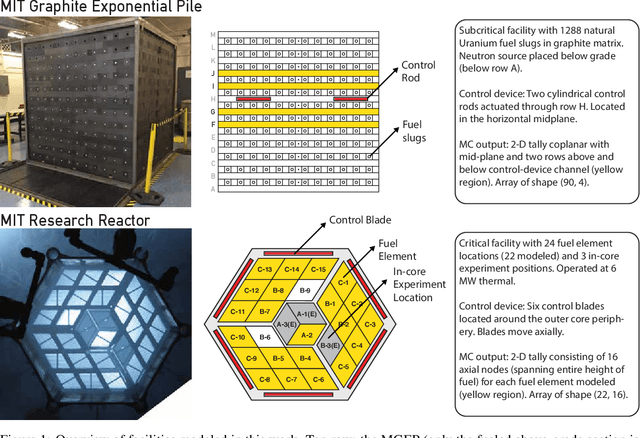Benoit Forget
Department of Nuclear Science and Engineering, Massachusetts Institute of Technology, Cambridge, MA, USA
Tetris-inspired detector with neural network for radiation mapping
Feb 07, 2023Abstract:In recent years, radiation mapping has attracted widespread research attention and increased public concerns on environmental monitoring. In terms of both materials and their configurations, radiation detectors have been developed to locate the directions and positions of the radiation sources. In this process, algorithm is essential in converting detector signals to radiation source information. However, due to the complex mechanisms of radiation-matter interaction and the current limitation of data collection, high-performance, low-cost radiation mapping is still challenging. Here we present a computational framework using Tetris-inspired detector pixels and machine learning for radiation mapping. Using inter-pixel padding to increase the contrast between pixels and neural network to analyze the detector readings, a detector with as few as four pixels can achieve high-resolution directional mapping. By further imposing Maximum a Posteriori (MAP) with a moving detector, further radiation position localization is achieved. Non-square, Tetris-shaped detector can further improve performance beyond the conventional grid-shaped detector. Our framework offers a new avenue for high quality radiation mapping with least number of detector pixels possible, and is anticipated to be capable to deploy for real-world radiation detection with moderate validation.
Empirical Models for Multidimensional Regression of Fission Systems
May 30, 2021



Abstract:The development of next-generation autonomous control of fission systems, such as nuclear power plants, will require leveraging advancements in machine learning. For fission systems, accurate prediction of nuclear transport is important to quantify the safety margin and optimize performance. The state-of-the-art approach to this problem is costly Monte Carlo (MC) simulations to approximate solutions of the neutron transport equation. Such an approach is feasible for offline calculations e.g., for design or licensing, but is precluded from use as a model-based controller. In this work, we explore the use of Artificial Neural Networks (ANN), Gradient Boosting Regression (GBR), Gaussian Process Regression (GPR) and Support Vector Regression (SVR) to generate empirical models. The empirical model can then be deployed, e.g., in a model predictive controller. Two fission systems are explored: the subcritical MIT Graphite Exponential Pile (MGEP), and the critical MIT Research Reactor (MITR). Findings from this work establish guidelines for developing empirical models for multidimensional regression of neutron transport. An assessment of the accuracy and precision finds that the SVR, followed closely by ANN, performs the best. For both MGEP and MITR, the optimized SVR model exhibited a domain-averaged, test, mean absolute percentage error of 0.17 %. A spatial distribution of performance metrics indicates that physical regions of poor performance coincide with locations of largest neutron flux perturbation -- this outcome is mitigated by ANN and SVR. Even at local maxima, ANN and SVR bias is within experimental uncertainty bounds. A comparison of the performance vs. training dataset size found that SVR is more data-efficient than ANN. Both ANN and SVR achieve a greater than 7 order reduction in evaluation time vs. a MC simulation.
 Add to Chrome
Add to Chrome Add to Firefox
Add to Firefox Add to Edge
Add to Edge